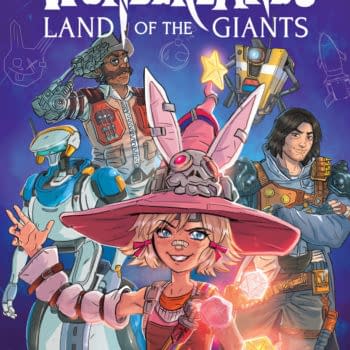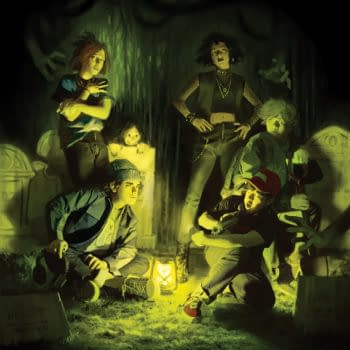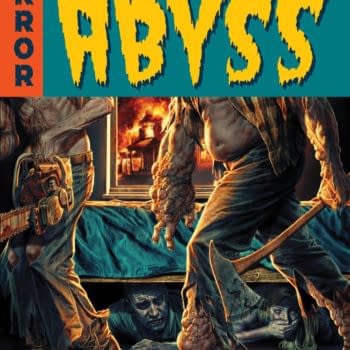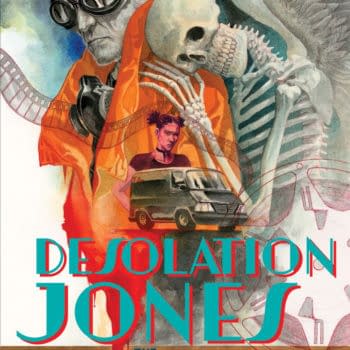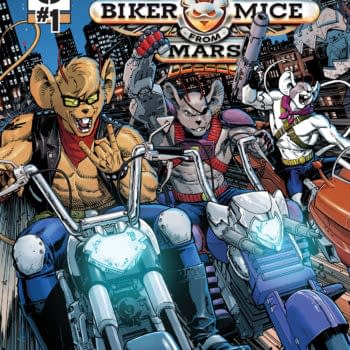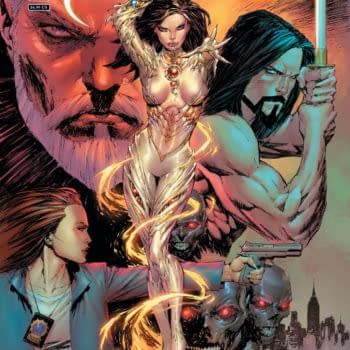Posted in: Comics, Recent Updates | Tagged: convergence, dark horse, dc comics, entertainment, first second, Harrow County, In Real Life, marvel, Secret Wars
Thor's Comic Review Column – Convergence Week 6, Harrow County #1, In Real Life, Secret Wars #2
This Week's Reviews:
Convergence #6
Convergence: Suicide Squad #1
Convergence: Supergirl Matrix #2
Harrow County #1
In Real Life
Secret Wars #2
Convergence Week 6
By Graig Kent
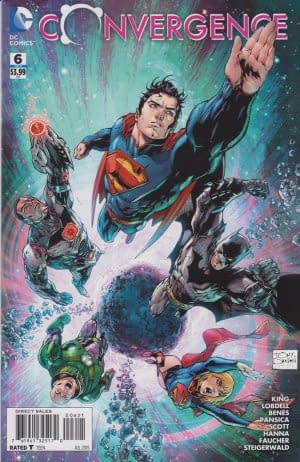
Of course, with so many heroes on the planet, they will not bow so easily, and naturally it's pre-Flashpoint Superman who takes charge and starts rallying everyone together. Superman leaves it to Earth 2 Dick Grayson to connect with Telos and convince him to enlist in their fight against the wizard of Skartaris. But Deimos has gained followers from the Extremists to the Crime Syndicate to the Flashpoint "heroes", so the battle is staged for issue 7.
Like last week, this issue manages to increase the scale of the event, mainly by bringing more characters into it. Even though it seems like it was tacked onto the beginning, that opening sequence in "our universe" adds a component that's been conspicuously absent since the zero issue. And the fact that the events on Telos are now having an impact on the main DCU in a weird way legitimizes what's been a rather illegitimate event to this point.
Though becoming more enjoyable, in part as a result of continuing to scale back the focus on the Earth 2 heroes, this is still a flawed event story. Jeff King seems to have abandoned doing anything with the Time Masters (perhaps it's left for Convergence: Booster Gold #2 in week 8 to handle), and likely a result of shoehorning in the opening New 52 pages, he seems to have unfortunately hampered his own ability to develop Telos any further this issue. King's incidental dialogue, though, is on point this issue. He nails the colliding multiverses, with simple, even punchy exchanges between characters that are genuinely fun. Penciler Eduardo Pansica doesn't really handle the colliding multiverses as well. His storytelling is generally fine, no real complaints, except when it comes to the big congregation of heroes descending on Deimos, it's wholly underwhelming. The two page spread of the "villains" congregating is slightly more impressive but it's still not busy enough. Readers should be pouring over these pages, spending a half hour picking out the various heroes and villains. As is you can identify them all with ease in about a minute.
I hope next issue isn't just a "this side" versus "that side" punching affair. We've had enough of that in all the tie-in two parters already. Like how issue 5 changed the game, I'm hoping there's a twist at play that keeps raising the stakes.
—
Even though I picked up four of the ten "Zero Hour" tie-ins in Week 2, I only continued with two of them for Week 6. I even scanned through the follow-up issues to the ones I didn't read in Week 2 to see if anything caught my eye (Convergence: Superboy #2 and Convergence: Aquaman#2 both had very attractive art, but nothing on a flip through stood out as being very essential). Truth told, the back-up 8-page previews for DC's new series launching in June were drawing my attention far more than the Convergence stories.
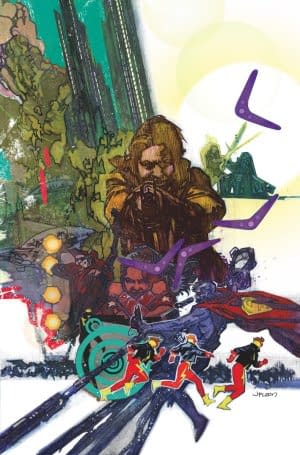
The back-up here is the new direction for Aquaman, with Cullen Bunn on board as writer and Trevor McCarthy on art. The new direction finds Arthur Curry on the run from Atlantis, with Mera calling for his head. Bunn and McCarthy do a good job in this short of making Aquaman a total badass ("YOUR KING IS PISSED!"), with McCarthy's art adding particular grit not commonly associated with the character. The character design, as well, seems to be swaying a bit more to what little we've seen teased of Jason Momoa in the role. A fine 8-page read, but, that said, I'm not at all invested in this new direction.
—
Easily having the most fun with the event, writer Keith Giffen brings back to the comics page his 17th most famous creation, Ambush Bug in Convergence: Supergirl Matrix #2 (DC, $3.99). That alone should be enough to ward off/draw in many a comic fan from this totally gonzo, metatextual affair which sees the bug bouncing around from city to city with Supergirl in pursuit (and Lady Quark in pursuit of her). Giffen debuts his Spider-Man variant, Louse-Man, from his weirdo Marvel analog planet (home to the Extremists, his 32nd most famous creation) and the character notes, after meeting Supergirl/Matrix, "Wow… she had beautiful hair….". And it's true, the way Timothy Green II draws Supergirl, she has a ridiculously intricate nest of perpetually flowing blond tendrils, and it's quite fetching. Green also gives her a long, flowing red Spawn-style cape which should be in the way far more than it is. There's no real conclusion to the story, as Giffen doesn't seem particularly concerned with finality, so he gives Ambush Bug a Looney Toons moment to close it all out. It's left-field, yes, and yet utterly apt.
This book's apt preview is of June's Bat-Mite, written by Dan Jurgens with art from Corin Howell. Howell's art is key here, as Bat-Mite has a hard time existing in a realistically illustrated fashion. His style then works well, with more than a hint of Amanda Conner in the works. Mike Atiyeh's colours help things along even more giving it a watercolor texture that convey a Little Golden Book feel. Jurgens isn't exactly a writer known for his humour, he's more of a straight-up superhero storyteller, so he seems like an odd choice to helm a literal "funnybook". He does a decent job, I do admit, but compare this to, say, The Unbeatable Squirrel Girl written by Ryan North which is laugh-out-loud funny and it kind of pales.
—
Next week, Convergence #7, and likely one, maybe two tie-ins.
Graig Kent is kind of ready to be done reviewing Convergence.
Harrow County #1 (Dark Horse, $3.99)
By Cat Taylor
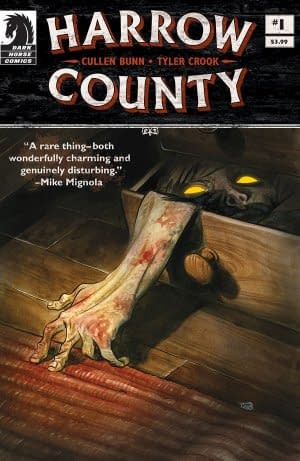
For one, the writer, Cullen Bunn, has put some thought and humanity into the characters who were involved in the witch-burning, making neither the witch nor her killers 100% hero or villain. In this story, the villagers know about, and are compliant, with the witchcraft because the witch uses her magic to help the villagers. Therefore, it's easy for them to turn a blind eye to the cattle sacrifices she makes in exchange. As time goes by, what she does in exchange for her abilities becomes more and more detrimental. A panel prior to the depiction of the witch being executed strongly implies that she has sacrificed, or was about to sacrifice a human baby prior to the villagers turning on her. Even during the slaying and after the witch is killed, remorse is felt by many of the villagers because this was a woman that they knew, had helped in the past, and had been somewhat of a friend to many of them. So, although both parties are evidently guilty of murder and perhaps more, the writer has established motives and some sympathy for his characters. When a writer can humanize literary subjects, the horror becomes all the more effective. Bunn has also done a lot of work for Marvel and DC, as well as the excellent Sixth Gun series. He's proven himself as a master storyteller and may be the most underrated comic book writer currently working. Therefore, I can't imagine that he is going to disappoint with future issues of Harrow County.
While most of the first issue is spent establishing the back story, the remainder is where things get truly interesting as we see the main characters in their present day. During this part of the comic, some of the older people discuss the witch's curse and what they have done to keep it from taking effect. This discussion is presented in the vaguest way possible. So, as readers, we still don't really know what the curse is or what they have been doing about it. However, we are given the impression that both the curse and the remedy are pretty nasty. What is clear is that one of the main characters, a young girl about to turn eighteen is the current focus of the curse. The things she has been experiencing, is currently experiencing, and is going to experience in the next issue are situations that are going to take this story into some intriguing areas. I've really got to hand it to Bunn for building enough cliffhangers to keep an audience past this initial issue.
In horror comics, I typically expect some influence of a master like Berni Wrightson when it comes to the art. After all, creepy visuals are every bit as useful in conveying a feeling of fear and dread as the writing is, and perhaps moreso. In this case though, the Eisner award-winning artist, Tyler Crook, doesn't go for the creepy route as much as for a vintage look that reminded me more of the illustrations in many of the old children's books my grandmother read to me as a child. I'm not referring to a cartoony Disney look, but rather the kind of sketchy illustrations that accompanied the more dramatic children's stories like some of the Grimm's fairy tale books. I like the choice made there since the story itself is a take on tales that were around since well before I was born. It added to the feeling that I was reading a story that occurred long ago. This isn't to say that there aren't creepy drawings though. When something is meant to look scary, Crook doesn't hold back on monstrous imagery.
I've said many times before that it is really tough to do horror well but I'm impressed with this series so far. The first issue starts about as strongly as any comic of its kind could. Regardless, I can see the possibility of some people feeling like there's too much back story that's too cliché in the first issue. On the other hand, readers like me will likely appreciate the subtleties that are included and recognize the first issue as a slow build with the potential for future issues to go completely over the top. If that's what you're into, I can't think of another title that's currently doing anything as effective as Harrow County.
Cat Taylor has been reading comics since the 1970s. Some of his favorite writers are Alan Moore, Neil Gaiman, Peter Bagge, and Kurt Busiek. Prior to writing about comics, Taylor performed in punk rock bands and on the outlaw professional wrestling circuit. During that time he also wrote for music and pro wrestling fanzines. Rock over London. Rock on Chicago. Wheaties, breakfast of champions. You can e-mail Cat at cizattaylor@hotmail.com.
In Real Life (First Second, $17.99)
By Adam X. Smith

Cory Doctorow and Jen Wang's In Real Life (IRL) is described in the foreword as a story about gaming and economics. Anda is a student who joins an all-female guild on an MMORPG called Coarsegold Online, where she encounters a young Chinese player who is gold-farming – a practice that is technically against the rules of the game but it is nonetheless his livelihood. Concerned for his real-world wellbeing, she tries to advise him on pressing his boss for better healthcare, but is forced to learn that different cultures – be they real or virtual – resist simplicity, especially when it comes to making meaningful and necessary changes to them.
Doctorow's work has always been best when he's telling stories based around a post-internet society in which everyone and everything is connected, and that deal with concepts of politics and economics that affect people directly without dumbing it down for the laypersons. IRL deals with everything from gender roles within the gaming community to wage poverty and the difficulties faced by people in obtaining healthcare or unionising, augmented by the way these realities are present in the game. He doesn't pretend that the internet is a cure-all for our problems – it is only a tool to organise collectively to push toward our goals.
What IRL presents, through Doctorow's words and Wang's gorgeous artwork, is a glimpse of where our growing online footprint leads to, how the virtual world that was once a clunky and abstract construct is slowly becoming an extension of our real-world lives. The closest comparison I can make in terms of its fidelity to the presentation of the digital space and its interactions with the real world is Mamoru Hosoda's Summer Wars.
Fellow writer and punk-rock prognosticator Warren Ellis once said "To be a futurist, in pursuit of improving reality, is not to have your face continually turned upstream, waiting for the future to come. To improve reality is to clearly see where you are, and then wonder how to make that better." IRL is all about seeing that bigger picture, that what occurs in the virtual world can be just as significant as in "real life", and that what affects one can affect the other, so long as someone is willing to stand up and fight for change. It is a story about gaming and economics that is also a heart-warming tale of friendship that spans both the globe and cyberspace, and if you have got to the end of this review without rolling your eyes or snorting cynically, you should pick it up immediately.
Adam X. Smith had to spend a lot of time reading about famous assassinations recently. He hopes for the commenters' sake it doesn't awaken anything in him.
Secret Wars #2 (Marvel, $4.99)
By Jeb D.
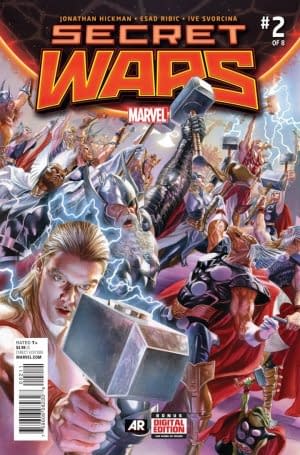
If Secret Wars #1 was the summation of Jonathan Hickman's Avengers/FF/Ultimate work, issue #2 is where we get the shape of the Battleworld story. The events of issue #1 have given way to a quasi-postapocalytpic-and-sorta-medieval world where Victor Von Doom is, and has always been, God-King, and warring houses vie for his favor. The influence of Game of Thrones is palpable, with some fairly blatant nods to 2000 A.D., as well. The laws of this new order are enforced by an army of Thors, with a new recruit's indoctrination serving as our introduction to Doom's world. There are a few survivors of the colliding Earths of issue #1, with challenges to Doom's rule starting to bubble up from both Thanos' Cabal, and more pointedly, from the remnants of the Future Foundation, whose fealty to science over faith is raising dangerous questions about whether Doom is, indeed, all that there has ever been or will be.
Quite apart from the question of what will come out of Secret Wars, the event itself is very much for fans of series like Exiles, House of M, Marvel Noir, or 1602: its principal, if somewhat slight, virtues, are in seeing familiar Marvel characters in unusual juxtaposition… which, in a way, makes it tricky to review: the issue's highlight is seeing an oddly matched pair of characters engaged in a "trial by combat" reminiscent of the Red Viper-Mountain battle from Game of Thrones, but half the fun is not knowing in advance who they are. Hickman brings a certain bleak inevitability to the roles assigned to some of our favorites; at least a couple of these characters are going to need therapy after they wake up one day, and remember what they once did at Doom's behest.
As to Doom himself, his appearance here is pretty muted: he mostly sits sullenly on his throne. It may be an illustration of the old saw that the quest matters more than the goal, but it does mean that Marvel's greatest villain spends this issue serving more as a piece of the scenery than the vibrant character he is at his best.
Esad Ribic and colorist Ive Svorcina are, again, the ideal team to show us the contrast between Doom's misty, mythic, vaguely Asgardian world and the science-based knowledge that will threaten it. Ribic's facial work is more expressive than it is consistent, and he captures some wonderful moments of hauteur, compassion, wonder, and humor. We're a bit shorter on space battles than last time, but the art nicely evokes the emergence of darker interpersonal conflicts.
To the extent that the comic reading community frets about whether what we're seeing from Marvel amounts to reboot, restart, recap, recontextualization, or jumping-on point, and what it all means for the comics that will be coming out afterwards, it would actually be easy for Secret Wars itself to get lost in the shuffle. Issue #1 was a somewhat awkward way to bring closure to decades' worth of continuity, but issue #2, in effect, starts a new story, featuring the panoply of Marvel characters as a sort of virtual repertory company, trying on different roles for our amusement. It looks like an entertaining ride, and will become even more so once ol' Vic gets up off his ass and joins the fun.
Jeb D. is engaged in a secret war against crappy stage microphones and sleep deprivation.










